Related Research Articles
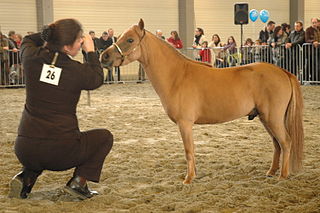
A miniature horse is a breed or type of horse characterised by its small size. Usually it has been bred to display in miniature the physical characteristics of a full-sized horse, but to be little over 100 cm (40 in) in height, or even less. Although such horses have the appearance of small horses, they are genetically much more similar to pony breeds such as the Shetland. They have various colors and coat patterns.

The Lusitano, also known as the Pure Blood Lusitano or PSL, is a Portuguese horse breed. Horses were known to be present on the Iberian Peninsula as far back as 20,000 BC, and by 800 BC the region was renowned for its war horses. The fame of the horses from Lusitania goes back to the Roman Age, which attributed its speed to the influence of the West wind, who was considered capable of fertilizing the mares. When the Muslims invaded Iberia in 711 AD, they brought Arabian horses with them that were crossed with the native horses, developing a horse that became useful for war, dressage and bull fighting. The Portuguese horse was named the Lusitano, after the word Lusitania, the ancient Roman name for the region that modern Portugal occupies. There are four main breed lineages within the breed today, and characteristics differ slightly between each line.

The National Show Horse originated as a part-Arabian cross between an American Saddlebred and an Arabian horse. It is now established as a separate breed, since the founding of a breed registry in August 1981. Registered animals today may be the offspring of registered NSH parents or may be a combination between an American Saddlebred, Arabian, and a National Show Horse. Non-NSH mares and stallions must be registered with their appropriate registries, and stallions who are Arabian or Saddlebred must additionally be nominated and approved by the NSHR board of directors. Although any combination of these three breeds may be used, as of December 1, 2009 there must be at least 50% Arabian blood in the horse to be registered, up to 99% Arabian blood.

The Pony of America is a pony breed developed in the state of Iowa in the United States. The foundation stallion was an Arabian/Appaloosa/Shetland pony cross. A breed registry was founded in 1954, and within 15 years had registered 15,000 ponies. Today, the Pony of the Americas Club is one of the largest and most active youth-oriented horse breed registrie in the US. Although called ponies, POAs have the phenotype of a small horse, combining mainly Arabian and American Quarter Horse attributes. The registry is open, allowing blood from many other breeds, but has strict criteria for entry, including Appaloosa coloration, specified height and other physical characteristics. Although mainly bred for Western riding, the breed has been used for many other disciplines, including driving, endurance riding and some English disciplines.
The Galiceno is a horse breed developed in Mexico, bred from horses brought from Spain by Hernán Cortés and other conquistadors. Although small in stature, they are generally considered a horse, rather than a pony, and are always solid-colored. In Mexico, they are an all-around horse, used for riding, packing and light draft. In the United States they are often used as mounts for younger competitors, although they are also found competing in Western events. The breed descends from horses brought from Spain to Mexico during the 16th century. Many of these horses escaped or were released and formed feral bands in the interior of Mexico, which were then captured by local inhabitants. They were also often used by Spanish missionaries to the American West, where they became some of the ancestors of the American Indian Horse. In 1958, these horses were first imported to the United States, and in 1959 a breed registry was formed. Many of the horses are also registered with the American Indian Horse Registry.
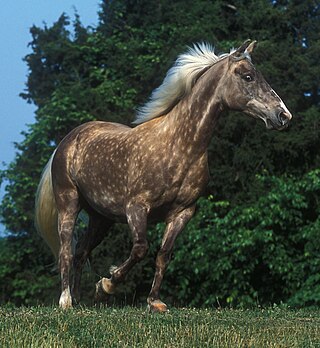
The Rocky Mountain Horse is a horse breed developed in the state of Kentucky in the United States. Despite its name, it originated not in the Rocky Mountains, but instead in the Appalachian Mountains. A foundation stallion, brought from the western United States to eastern Kentucky around 1890, began the Rocky Mountain type in the late 19th century. In the mid-20th century, a stallion named Old Tobe, owned by a prominent breeder, was used to develop the modern type; today most Rocky Mountain Horses trace back to this stallion. In 1986, the Rocky Mountain Horse Association was formed and by 2005 has registered over 12,000 horses. The breed is known for its preferred "chocolate" coat color and flaxen mane and tail, the result of the relatively rare silver dapple gene acting on a black coat, seen in much of the population. It also exhibits a four-beat ambling gait known as the "single-foot". Originally developed as a multi-purpose riding, driving and light draft horse, today it is used mainly for trail riding and working cattle.
The Welara is a part-Arabian pony breed developed from the Arabian horse and the Welsh pony. It was originally bred in England by Lady Wentworth at the Crabbet Arabian Stud in the early 1900s from imported Arabian stallions and Welsh pony mares. Breeding then spread throughout North America. In 1981, a breed registry was formed in the United States, and a studbook began to be published. They are used for many disciplines of English riding, and are known for their refinement, hardiness and spirit.

The Nokota horse is a feral and semi-feral horse breed located in the badlands of southwestern North Dakota in the United States. The breed developed in the 19th century from foundation bloodstock consisting of ranch-bred horses produced from the horses of local Native Americans mixed with Spanish horses, Thoroughbreds, harness horses and related breeds. The Nokota was almost wiped out during the early 20th century when ranchers, in cooperation with state and federal agencies, worked together to reduce competition for livestock grazing. However, when Theodore Roosevelt National Park was created in the 1940s, a few bands were inadvertently trapped inside, and thus were preserved.
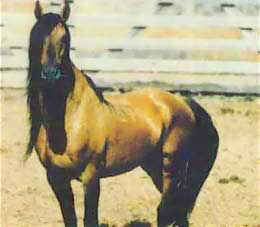
The Kiger mustang is a strain of mustang horse located in the southeastern part of the U.S. state of Oregon. The name applies only to wild-captured individuals and does not apply to their bred-in-captivity progeny, which are known as Kiger horses. The Bureau of Land Management (BLM) administers two herd management areas for Kiger mustangs in the Burns District—Kiger and Riddle Mountain, in the Steens Mountain area. DNA testing has shown that Kiger mustangs are descended largely from Spanish horses brought to North America in the 17th century, a bloodline thought to have largely disappeared from mustang herds before the Kiger horse populations were discovered in 1977.
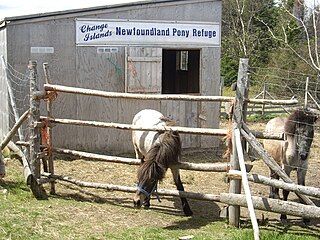
The Newfoundland pony is a breed of pony originating in Newfoundland, Canada. They are sturdy and muscular ponies, found in many colors, including the relatively rare white coloration. The Newfoundland developed from a mix of English, Irish, and Scottish pony breeds brought to Newfoundland by settlers over a period of four centuries. Initially free-roaming, they crossbred to produce the modern type. They were used by settlers as draft and multi-purpose ponies until the mid-20th century century, when they were brought almost to the point of extinction by mechanization and slaughter. The population rebounded slightly after the formation of a breed registry in 1980, but still remains low. In 1997, the Newfoundland pony was declared a heritage breed of Newfoundland and Labrador, which afforded it protection under the law, but the breed has not yet been recognized under the Canadian federal Animal Pedigree Act. As of 2008, there were 248 registered ponies of breeding age, out of a total population of 361. In 2013, the widely dispersed breeding population is still estimated at between 200 and 250 animals.

The Florida Cracker Horse is a critically endangered horse breed from the state of Florida in the United States. It is genetically and physically similar to many other Spanish-style horses, especially those from the Spanish Colonial horse group, including the Banker horse of North Carolina, and the Carolina Marsh Tacky of South Carolina.
The Abaco Barb or Abaco Spanish Colonial Horse was a breed or population of feral horses on the island of Great Abaco, in the Bahamas. It became extinct in 2015; it was the only horse breed of the Bahamas.
The Banker horse is a breed of semi-feral or feral horse living on barrier islands in North Carolina's Outer Banks. It is small, hardy, and has a docile temperament, and is genetically related to the Carolina Marsh Tacky of South Carolina and Florida Cracker Horse breeds through their shared Colonial Spanish horse and Iberian horse descent. The current population of wild Banker horses is estimated to be about 400.
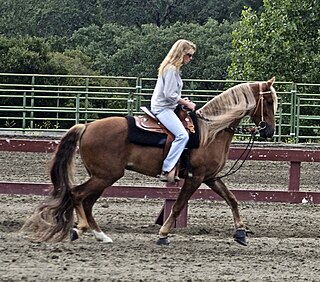
The Kentucky Mountain Saddle Horse is a horse breed from the U.S. state of Kentucky. Developed as an all-around farm and riding horse in eastern Kentucky, it is related to the Tennessee Walking Horse and other gaited breeds. In 1989 the Kentucky Mountain Saddle Horse Association (KMSHA) was formed, and in 2002, the subsidiary Spotted Mountain Horse Association (SMHA) was developed to register Kentucky Mountain Saddle Horses with excessive white markings and pinto patterns. Conformation standards are the same for the two groups of horses, with the main difference being the color requirements. The KMSHA studbook is now closed to horses from unregistered parents, although it cross-registers with several other registries, while the SMHA studbook remains open.
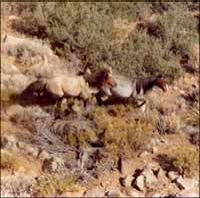
The Cerbat mustang is a feral horse population of Arizona, found in the Cerbat Herd Management Area in that state. Their main coat colors are chestnut, bay, and roan. While their phenotype is similar to the classic Colonial Spanish horse, the actual origin of Cerbat mustangs is unclear, but they have been identified by DNA testing as of Colonial Spanish horse ancestry, and they are recognized by the Spanish Mustang registry as valid foundation stock for that standardized breed. Cerbats possess the ability to gait.
Old Tobe was the foundation sire of the Rocky Mountain Horse breed. He was owned by Sam Tuttle, and used as a trail horse in Kentucky's Natural Bridge State Park. Old Tobe was gaited, and passed the trait to his offspring.

The Ojibwe Horse, also known as the Lac La Croix Indian Pony and Lac La Croix “Indian” or “Indigenous” pony is a semi-feral Canadian horse breed developed by the Ojibwe people. The population became critically low; and, by 1977, only four mares remained. To preserve the breed, these mares were crossed with Spanish Mustang stallions. The modern breed name derives from the Lac La Croix First Nation of Ontario, where the horses were last found in the wild. Historically, the breed was also found in Minnesota.
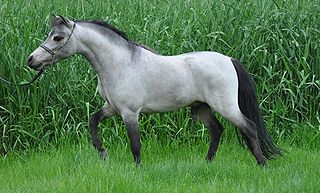
The American Miniature Horse is an American breed of small or miniature horse. It has been selectively bred to display in miniature the physical characteristics of a full-sized horse, and usually stands no taller than about 38 in (97 cm). It frequently has the appearance of either a small Arab or a small draft horse; genetically it is no different to pony breeds such as the Shetland.
The Canadian Sport Horse is a studbook of sport horses managed in Canada. These horses are crossbred between Thoroughbred stallions and local, Canadian-bred mares. It was formerly known as the Canadian Hunter; a breed society was formed in 1926. The breed name was changed in 1984.
References
- ↑ Judith Dutson (2005). Storey's Illustrated Guide to 96 Horse Breeds of North America. p 181-183. North Adams, Massachusetts: Storey Publishing. ISBN 9781580176132.
- 1 2 Dutson, Judith (2005). Storey's Illustrated Guide to 96 Horse Breeds of North America. 210 Mass MoCA Way, North Adams, MA 01247: Storey Books. pp. 181–184. ISBN 9781580176125.
{{cite book}}: CS1 maint: location (link) - ↑ "Breeds of Livestock - Moyle Horses — Breeds of Livestock, Department of Animal Science". 30 March 2021.
- ↑ Valerie Porter, Lawrence Alderson, Stephen J.G. Hall, D. Phillip Sponenberg (2016). Mason's World Encyclopedia of Livestock Breeds and Breeding (sixth edition), p. 487-488. Wallingford: CABI. ISBN 9781780647944.
- ↑ Hendricks, Bonnie; Anthony A. Dent (2007). International Encyclopedia of Horse Breeds. University of Oklahoma Press. pp. 296–299. ISBN 978-0-8061-3884-8.